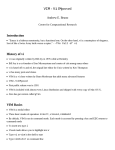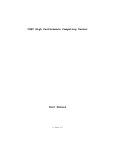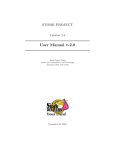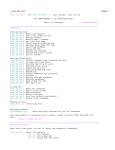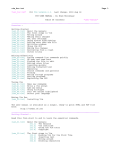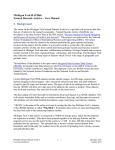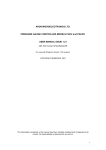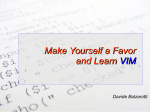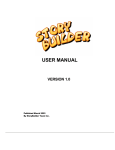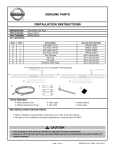Download Introduction to UNIX Editors
Transcript
Introduction To Unix Editing Tools Steve Gallo and Andrew Bruno Center for Computational Research University at Buffalo State University of New York CCR Summer Seminar Series, 2012 6/20/2012 CCR Summer Workshop Series - Editors 1 Introduction There are many editors to choose from, both graphical and textbased. • • • • • VIM Emacs Gedit Nano Sublime Text 2 … and the list goes on http://en.wikipedia.org/wiki/List_of_text_editors 6/20/2012 CCR Summer Workshop Series - Editors 2 Review – Environment Variables Environment variables control various aspects of your environment and applications. These can be set in your login scripts, by applications, or on the command line bash: export EDITOR=/usr/bin/emacs csh: setenv VISUAL /usr/bin/vi Useful environment variables • EDITOR and VISUAL – set the editor used by various applications • PATH – A colon-separated list of directories searched for applications to run (e.g., PATH=/bin:/usr/bin:/usr/local/bin) • HOME – Your home directory on the machine 6/20/2012 CCR Summer Workshop Series - Editors 3 Review – Job Control Unix supports the notion of foreground and background processes. When you run an application (i.e., a job) from the command line it typically runs in the foreground, but you can also run it in the background using the “&” operator. # Run emacs in the foreground. The shell waits for you to exit emacs. $ emacs test.c # Run emacs in the background - you are returned to the shell. $ emacs test.c & $ Use C-z to suspend an job and return to the shell. Type “bg” to continue running the job in the background or “fg” to return to the job. Useful for suspending a job to perform a task and then returning to it. For example, # Use vi to edit a file but you forgot to do something and don’t want to lose your place! $ vi test.c ^Z # The less command is now suspended $ cp /some/file . $ jobs [1]+ Stopped vi test.c $ fg # Now you’re back in vi where you left off 6/20/2012 CCR Summer Workshop Series - Editors 4 Editors Emacs and Vim are commonly installed on Unix systems. Topics • Opening and saving files, navigating, selection, cut-and-paste • Auto-completion, syntax highlighting, modes • Advanced editing: buffers, regions • Exercises Advanced Topics for Programmers • Customizations • Remote editing ≠ 6/20/2012 CCR Summer Workshop Series - Editors 5 Emacs Guided Tour http://www.gnu.org/software/emacs/tour/ Online Manual http://www.gnu.org/software/emacs/manual/html_mono/emacs.html Need a better editor for Windows? Use Emacs! http://ftp.gnu.org/gnu/emacs/windows/ Help from within Emacs M-x info M-x help 6/20/2012 CCR Summer Workshop Series - Editors 6 Emacs – Notation M-x is used to run a command Stands for Meta-x (modifier) and means press the escape key followed by “x” For example, M-x tetris starts a tetris game Use tab twice to see all commands that start with a string or all available options! C-x is a shortcut for a command, typically followed by a command key Press the control key at the same time as “x” typically followed by a shortcut key For example, C-x C-s will save your file 6/20/2012 CCR Summer Workshop Series - Editors 7 Emacs – Entering and Exiting Files Two modes of operation: In its own window (graphical mode) or within a terminal (text mode - useful for editing files remotely). # Run emacs in “no window” mode within a terminal $ emacs –nw GoogleScholar.php # Run emacs in its own window (in the background) $ emacs GoogleScholar.php & $ How do I exit Emacs and save my work? Key Description C-x C-s Save a buffer to its file C-x s Save all modified buffers C-x C-w Save as C-x C-c Exit (asks to save any modified buffers) 6/20/2012 CCR Summer Workshop Series - Editors 8 The Emacs Window Cursor (point) Buffer Buffer name Buffer status 6/20/2012 Minibuffer Cursor position Mode CCR Summer Workshop Series - Editors 9 Emacs – Buffers and Regions Buffers • Any text being edited (such as a file) is contained in a buffer • A buffer doesn’t have to contain data from a file! • Every buffer has a name - typically the name of the file • You can switch between buffers (using C-leftmouse in graphical mode or C-x b) • You can split buffers to view several on the screen at once Regions • A region is a marked area within a buffer (e.g., a selection) • Many operations can be performed on an entire buffer or a region Buffer 6/20/2012 Region CCR Summer Workshop Series - Editors 10 Emacs – Moving Around The arrow keys let you move around easily within Emacs, but to be more productive you can also use command keys! Key Description arrows up, down, left, right C-p , C-n , C-b , C-f up, down, left, right C-arrow Same as arrow but moves a whole word C-a (or Home key) Move to the beginning of the line (also works in the shell) C-e (or End key) Move to the end of the line (also works in the shell) C-v and M-v Page down and Page up M-g g Go to line (I aliased this to M-: and yes I stole it from vi!) M-< and M-> Move to the top of the buffer and move to the bottom Why use C-a instead of the home key or C-f instead of the arrow? Isn’t that crazy? No! If you have one hand on the keyboard and one on the mouse every time you take your hand off of the mouse to click a key it slows you down. The same is true for copy and paste – if you take your hands off the keyboard to use the mouse menu it slows you down. Learning shortcuts can make you more productive. 6/20/2012 CCR Summer Workshop Series - Editors 11 Emacs – Cut and Paste Cut and paste in emacs is called “kill” and “yank”. Killing text puts that text into a buffer that you can then yank back out. Key Description C-k Kill a line from the cursor to the end of the line C-y Yank the contents of the kill buffer back into the document C-d Delete a single character under the cursor Backspace Delete the character before the cursor M-x cua-mode Don’t like C-k and C-y? Set Common User Access (CUA) mode! C-x, C-c, C-v, and C-z become cut, copy, paste, and undo. Cut and paste also works with regions. Select a region using the mouse in graphical mode or command keys. Move the cursor to another location and kill the text in the region. Regions are useful – more to come. Key Description C-<space> Set the mark at the cursor C-w Kill from the mark to the cursor 6/20/2012 CCR Summer Workshop Series - Editors 12 Emacs – Working With Rectangles We often need to operate on rectangular regions of text within a document. Delete a column, move it elsewhere, clear a column, etc. To select a rectangle, set the mark at one corner and move the cursor to the opposite corner. Key Description C-x r k Kill the rectangle C-x r y Yank a killed rectangle C-x r o Insert blank space into the marked rectangle, moving the current contents to the right. C-x r c Clear the rectangle leaving a blank space 6/20/2012 CCR Summer Workshop Series - Editors 13 Emacs – Opening Files Emacs can open several files at once, either from the command-line or within Emacs itself. # Open two files. The files will be displayed in a split window $ emacs GoogleScholar.php sample.txt & When opening a file from within emacs you can use tab-completion to browse for a file or enter dired (directory edit) mode to select a file. Key Description C-x C-f Browse or open a file C-x C-r Browse or open a file read-only C-x k Kill the current buffer and close the file 6/20/2012 CCR Summer Workshop Series - Editors 14 Emacs – Viewing Multiple Files You’ll often be working on multiple files and will want to view them at the same time. You can open multiple buffers or windows (frames), split the window horizontally, or split the window vertically. Key Description C-x 2 Split the current buffer horizontally into two C-x 3 Split the current buffer vertically into two C-x o Switch to other buffer (cycles through multiple buffers) C-x 0 Delete the current window C-x 1 Delete all windows EXCEPT the current window C-x 5 2 Open a new window (frame in Emacs-speak) 6/20/2012 CCR Summer Workshop Series - Editors 15 Emacs – Modes Every buffer in Emacs has a mode associated with it based on the type of data being displayed. Modes modify Emacs’ behavior to support common operations on the type of file being edited and sets the mode automatically based on the file extension. Indentation, highlighting of expressions and key words, and other languagespecific features are affected by the mode. Modes are highly customizable (but that is an advanced topic…) Key Description M-x php-mode Automatically indents code blocks, adds highlighting M-x text-mode Sets text mode. Automatically wraps text at 80 characters (can be changed) M-x auto-fill You can turn off auto fill mode while in text mode. This can be useful for editing data files. 6/20/2012 CCR Summer Workshop Series - Editors 16 Emacs – Useful Features Symbol completion while programming scholarL M-<tab> scholarList scholarListOfPublications … Entering multiple characters at once <esc> 80 -------------------------------------------------------------------------------- Adaptive fill mode - Create Simon & Carol an iRods account - Multiple zones connected to 2 different irods instances? (split Michigan public/private) - Search fields - Rule to read metadata from imported file and add to metadata - Create Simon & Carol an iRods account Multiple zones connected to 2 different - irods instances? (split Michigan public/private) Search fields Rule to read - metadata from imported file and add to metadata Undo Key Description M-<tab> Cycle through possible symbol completions <esc> <number> <char> Insert <number> of <char> M-x filladapt-mode Enable adaptive fill mode C-x u Undo recent editing 6/20/2012 CCR Summer Workshop Series - Editors 17 VIM 6/20/2012 CCR Summer Workshop Series - Editors 18 Introduction “Emacs is a hideous monstrosity, but a functional one. On the other hand, vi is a masterpiece of elegance. Sort of like a Swiss Army knife versus a rapier.” --The Cult of vi 6/20/2012 CCR Summer Workshop Series - Editors 19 History of vi • vi was originally written by Bill Joy in 1976 while at Berkeley • Bill Joy is a co-founder of Sun Microsystems and creator of csh among many others • vi is based off ex and ed, the original line editor for Unix written by Ken Thompson 6/20/2012 CCR Summer Workshop Series - Editors 20 History of vi.. • vi has many ports and clones • VIM is a vi clone written by Bram Moolenaar that adds many advanced features • VIM - Vi IMproved • First public release was in 1991 • VIM is included with almost every Linux distribution • Also has a GUI version called gVim 6/20/2012 CCR Summer Workshop Series - Editors 21 VIM Basics VIM is a modal editor • Three basic modes of operation: insert, visual, and command • By default, VIM is run in command mode. Each mode is accessed by pressing a key and ESC returns to command mode. • To insert text you need to switch to insert mode by pressing i • Visual mode allows you to highlight text. To enter visual mode press v • To view the VIM user manual type :help or :help [command] • Even will explain the meaning of life :help 42 6/20/2012 CCR Summer Workshop Series - Editors 22 VIM – Entering and Exiting Files Type vim (or just vi) in the shell to start. When vim starts you’ll be in normal (command) mode. # Run vim $ vim hello-world.c How do I exit vim and save my work? Command Description :w Save a buffer to its file :wa Save all modified buffers :w newfile Save as :q Exit :q! Exit without saving changes 6/20/2012 CCR Summer Workshop Series - Editors 23 VIM – Moving Around While in command mode: Key Description k,j,l,h up, down, left, right arrows up, down, left, right w Same as above but moves a whole word 0 (zero) Move to the beginning of the line $ Move to the end of the line C-f and C-b Page down and Page up 12g or :12<Enter> Go to line, (example go to line 12) gg G Move to the top of the buffer and move to the bottom ESC Return to command mode / ? Search forward and Search reverse yy p Copy entire line and paste Try using the “home row” for moving around. It allows you to navigate your file without moving your hand over to the arrow keys. k h l j 6/20/2012 CCR Summer Workshop Series - Editors 24 VIM Resources • VIM – http://www.vim.org • Cheat Sheets – http://www.viemu.com/a_vi_vim_graphical_c heat_sheet_tutorial.html 6/20/2012 CCR Summer Workshop Series - Editors 25

























